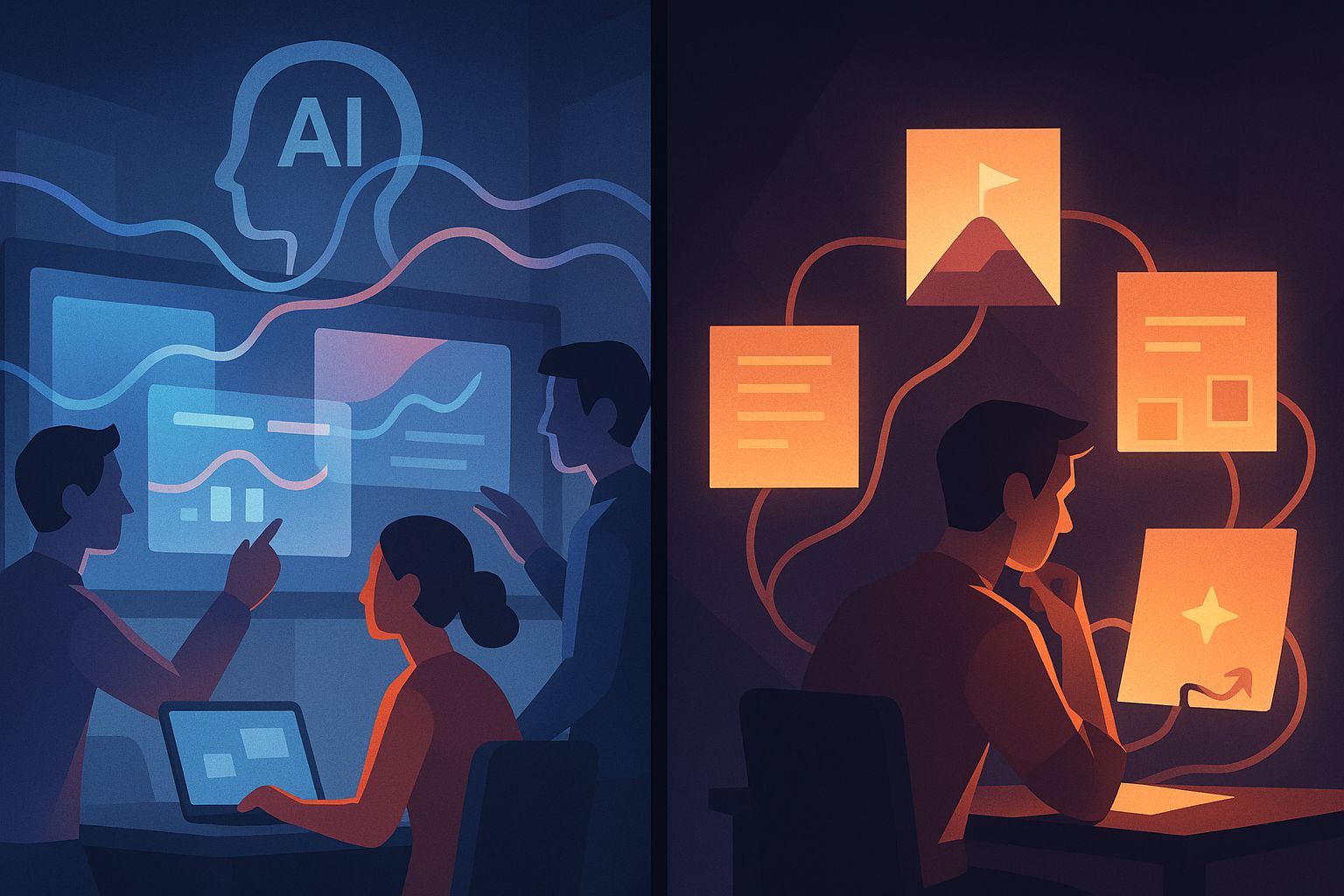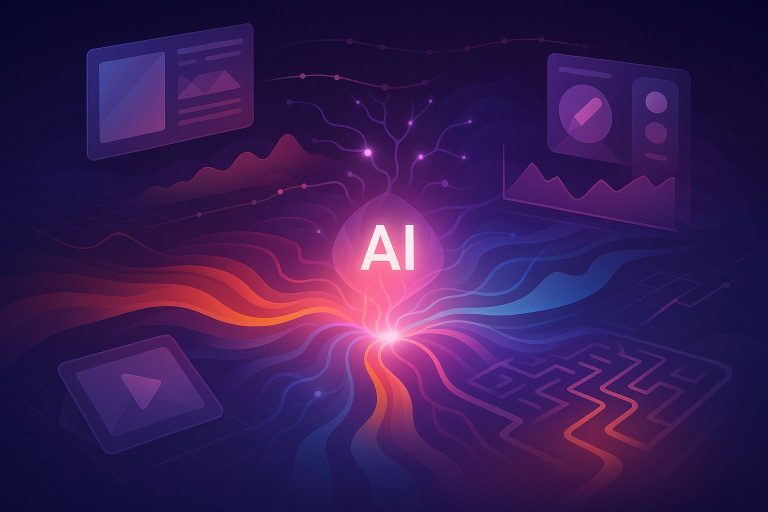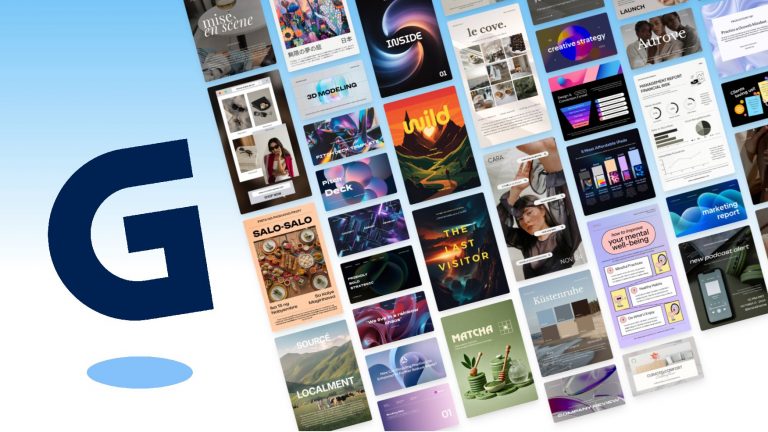Real-Time Collaboration Is Changing AI Presentations. Are We Losing the Plot?
AI is making real-time collaboration in presentations faster, but is this efficiency costing us the art of storytelling and true persuasion? Explore the balance between automation and authentic human connection in modern presentations.
Meta Description: AI is making real-time collaboration in presentations easier than ever. But is the focus on speed and automation causing us to forget what makes a presentation truly great?
What Got Me Thinking About This
I was on a discovery call with a new client last week, a creator who’s building a series of online courses. She was sharing her screen, walking me through her process on a tool that was part whiteboard, part slide-builder. She and her small team were dropping in sticky notes, which an AI was instantly clustering by theme. With another click, it generated a rough slide deck outline.
“The AI gets us a first draft in minutes,” she said, “and we can all be in here at the same time, tweaking it.”
On the surface, it was impressive. The friction of getting started was gone. But as I looked at the output, it was just… fine. It was a collection of facts, logically grouped, but it had no soul. No story. It made me wonder: in our rush to embrace AI-driven, real-time collaboration, are we optimizing for the wrong thing?
What’s Actually Changing
The shift isn’t just about adding an “AI” button to old software. The very workflow of creating a presentation is being re-architected around real-time, AI-assisted teamwork.
For years, collaboration meant sending a PowerPoint file back and forth, dealing with version control nightmares. Then came Google Slides, which let us edit simultaneously but was still a fairly static environment. Now, we’re in the third wave.
Platforms like Pitch, Gamma, and Canva are no longer just “presentation tools.” They are becoming complete collaborative workspaces. Pitch, for example, has rolled out features to co-present slides with smooth handoffs and lets you create shared “pitch rooms” with assets and analytics. Canva’s 2025 updates pushed it further into a full-fledged productivity suite, aiming to be a visual-first hub for teams.
The AI’s role in this new environment is twofold:
- Friction Removal: AI is automating the tedious parts. It generates first drafts from a prompt, suggests layouts, and ensures brand consistency, which helps non-designers create polished decks. This is a huge time-saver, with some claiming it can cut initial draft time by a factor of 50. From 2023 to 2024 alone, the use of AI in presentations grew by 160%.
- Idea Synthesis: Tools like Miro are using AI to make sense of collaborative chaos. You can throw a dozen ideas on a digital whiteboard, and the AI will group them by sentiment or keyword, summarize discussions, and even suggest action items. This turns a messy brainstorm into a structured outline almost instantly.
This isn’t a future trend; it’s happening now. The focus has moved from the individual creator to the interconnected team, with AI as the facilitator.
What People Are Missing
Everyone is rightly excited about the productivity gains. The ability for a team to go from a jumble of ideas to a polished deck in a single session is a game-changer. But we’re so focused on the how and the how fast that we’re ignoring the why.
The big thing people are missing is that collaboration and automation don’t automatically create persuasion.
A great presentation isn’t just a well-organized collection of information. It’s a narrative. It has an arc. It connects with an audience on an emotional level. And that’s a fundamentally human endeavor.
The current AI real-time collaboration trend optimizes for consensus and efficiency, not for a strong, singular, compelling point of view. When a team brainstorms and an AI synthesizes, the output is often the “average” of all the ideas—the safest, most logical path. It smooths out the quirky, outlier ideas where true genius often lies.
The result is a presentation that is technically correct and visually consistent, but often boring. It lacks a soul. It informs, but it doesn’t inspire. We’re getting really, really good at building slick, collaborative containers for mediocre stories.
What This Means for Presenters
For a course creator like my client, this is a critical distinction. Her goal isn’t just to present information; it’s to inspire students to learn and take action. Relying solely on an AI-synthesized group effort can strip the very personality and passion that makes her an effective teacher.
So, what should you do? Don’t ditch the tools. Instead, change how you use them.
- Use AI for Ideation, Not Storytelling: Let your team use tools like Miro or Gamma for the initial brain dump. Use the AI to cluster ideas and find patterns you might have missed. But then, step away. One person—the storyteller—needs to take that raw material and shape it into a narrative.
- Collaborate on the ‘What,’ Not the ‘How’: Use real-time tools to agree on the core message, the key data points, and the target audience. But don’t design by committee. Once the strategic foundation is set, let a single owner build the narrative flow.
- Treat the AI Draft as a Starting Point, Not the Finish Line: The AI-generated deck is your intern’s first pass. It’s a B-minus effort that saves you hours of grunt work. Your job is to provide the senior-level strategic thinking, the emotional intelligence, and the storytelling craft to elevate it to an A-plus.
- Inject Your Personality: As a course creator, your unique voice is your brand. After the collaborative and AI-driven parts of the process are done, go through the deck and rewrite key phrases in your own words. Add personal anecdotes. Replace a generic stock photo with a picture you took. Make it yours.
What I’ll Be Watching Next
I believe we’re at a peak of “efficiency-first” thinking in AI presentations. The next evolution won’t just be about making the process faster, but making the output better.
I’ll be watching for tools that move beyond layout and summarization to become true storytelling partners. Can an AI learn my personal speaking style? Can it analyze my raw content and suggest a more compelling narrative structure, like the “Hero’s Journey”? Can it identify moments where a personal story would be more effective than a bar chart?
The current trend of AI in real-time collaboration is powerful, but it’s incomplete. It’s given us the power to build presentations together, faster than ever. Now, we need to remember how to make them matter.
- Pillar Post: The Best AI Presentation Makers for 2025
- Support Pillar: How to Craft a Compelling Story with AI
- Support Pillar: Choosing Your AI Tool: Canva vs. Gamma vs. Pitch







